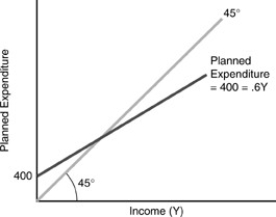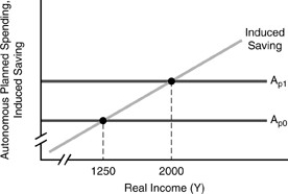A) caused by government tax and spending policies.
B) explained by changes in output,Y.
C) endogenous.
D) offset by government tax and spending policies.
F) A) and B)
Correct Answer

verified
Correct Answer
verified
Multiple Choice
In the four-part diagram used to construct the IS curve,a decrease in the interest rate causes
A) an increase in Ap and induced saving but does not shift the IS curve.
B) an increase in Ap and induced saving and shifts the IS curve to the right.
C) a decrease in Ap,an increase in induced saving,and shifts the IS curve to the right.
D) a decrease in Ap and a decrease in induced saving,but does not shift the IS curve.
F) None of the above
Correct Answer

verified
Correct Answer
verified
Multiple Choice
Figure 3-3
 -In Figure 3-3 above,equilibrium income is
-In Figure 3-3 above,equilibrium income is
A) 400.
B) 640.
C) 666.67.
D) 1,000.
E) 2,400.
G) B) and D)
Correct Answer

verified
D
Correct Answer
verified
Multiple Choice
Figure 3-4
 -In Figure 3-4 above,the multiplier is
-In Figure 3-4 above,the multiplier is
A) 2.5.
B) 0.6.
C) 0.4.
D) 1.67.
E) 1.5.
G) A) and C)
Correct Answer

verified
A
Correct Answer
verified
Multiple Choice
Figure 3-7
 -In Figure 3-7 above,if natural real GDP = $2500,AP = $250,and the change in "a" = change in I = change in NX = 0,the tax cut required to achieve then natural real GDP is
-In Figure 3-7 above,if natural real GDP = $2500,AP = $250,and the change in "a" = change in I = change in NX = 0,the tax cut required to achieve then natural real GDP is
A) $312.50.
B) $250.00.
C) $500.00.
D) none of the above.
F) A) and C)
Correct Answer

verified
Correct Answer
verified
Multiple Choice
The portion of net exports determined by income in foreign countries is
A) induced net exports.
B) autonomous net exports.
C) total net exports.
D) always equal to zero.
F) All of the above
Correct Answer

verified
Correct Answer
verified
Multiple Choice
If planned autonomous investment is 500,autonomous consumption 300,induced consumption 2500,savings 500,and government spending and taxes zero,then
A) Ep is 3300 and the economy is in equilibrium.
B) Ep is 3300 and the economy is out of equilibrium.
C) Ep is 3500 and the economy is in equilibrium.
D) Ep is 3500 and the economy is out of equilibrium.
F) A) and D)
Correct Answer

verified
Correct Answer
verified
Multiple Choice
If Ep is 3500 and Y is 3000,then companies will
A) reduce orders and production by 500.
B) increase orders and production by 500.
C) wait for final sales to increase but continue to produce at existing level in the future.
D) wait for final sales to decrease but reduce the level of production in the future.
F) All of the above
Correct Answer

verified
Correct Answer
verified
Multiple Choice
Income on the horizontal axis at which the vertical distance to the 45-degree line is less than the vertical distance to the Ep line gives rise to a ________ amount of unplanned inventory investment,and thus ________ pressure on output.
A) positive,upward
B) positive,downward
C) negative,upward
D) negative,downward
F) A) and B)
Correct Answer

verified
Correct Answer
verified
Multiple Choice
Assuming a simple Keynesian multiplier,and given an increase in planned investment of $100 billion,the effect on total output will be greater than $100 billion only if the
A) MPS is greater than zero.
B) MPC is zero.
C) MPS is less than zero.
D) MPC is greater than one.
F) A) and C)
Correct Answer

verified
Correct Answer
verified
Multiple Choice
During the 20th century,the highest savings rates in the U.S.were observed during
A) the Great Depression.
B) World War II.
C) the late 1980s and 1990s.
D) none of the above.
F) A) and C)
Correct Answer

verified
Correct Answer
verified
Multiple Choice
A falling interest rate ________ the number of investment projects having a positive profit rate,and thus ________ the amount of output that firms demand for themselves.
A) increases,raises
B) increases,lowers
C) decreases,raises
D) decreases,lower
F) A) and B)
Correct Answer

verified
Correct Answer
verified
Multiple Choice
Where the planned expenditure and the 45-degree lines intersect,the economy is ________ equilibrium,with unplanned inventory investment equal to ________.
A) in,zero
B) out of,zero
C) in,planned inventory investment
D) in,autonomous planned expenditure
E) out of,autonomous planned expenditure
G) D) and E)
Correct Answer

verified
Correct Answer
verified
Multiple Choice
If Y = income,G = government spending,T = autonomous taxes,and t = income tax rate,then the government budget deficit can be expressed as
A) G - T/Y(t) .
B) G - T.
C) Y + G - T - ty.
D) G - T - ty.
F) A) and B)
Correct Answer

verified
Correct Answer
verified
Multiple Choice
During a recession,automatic stabilization causes the government budget deficit to
A) fall.
B) increase.
C) remain stable.
D) move in the same direction as Y.
F) C) and D)
Correct Answer

verified
Correct Answer
verified
Multiple Choice
Income on the horizontal axis at which the vertical distance to the 45-degree line is less than the vertical distance to the Ep line gives rise to ________-than-equal planned expenditures,and so we must be ________ the equilibrium level of income.
A) less,below
B) less,above
C) greater,below
D) greater,above
F) None of the above
Correct Answer

verified
Correct Answer
verified
Multiple Choice
During recent Global Economic Crises,U.S.household liabilities have
A) increased
B) decreased
C) remained the same
D) quadrupled
F) A) and C)
Correct Answer

verified
Correct Answer
verified
Multiple Choice
Total income is always equal to ________ expenditures;but only in equilibrium is it equal to ________ expenditures,producing in equilibrium ________ on income to change.
A) actual,planned,pressure
B) actual,planned,no pressure
C) planned,actual,pressure
D) planned,actual,no pressure
F) All of the above
Correct Answer

verified
Correct Answer
verified
Multiple Choice
Since business firms will undertake a project whose rate of return exceeds the present level of interest rates,when interest rates
A) rise planned investment rises,ceteris paribus.
B) fall planned investment falls,ceteris paribus.
C) rise planned investment does not change.
D) rise planned investment falls,ceteris paribus.
F) A) and B)
Correct Answer

verified
Correct Answer
verified
Multiple Choice
If planned investment changes as interest rates change,then
A) autonomous consumption changes.
B) autonomous investment changes.
C) total expenditures and output changes.
D) the marginal leakage rate changes.
F) A) and D)
Correct Answer

verified
C
Correct Answer
verified
Showing 1 - 20 of 167
Related Exams